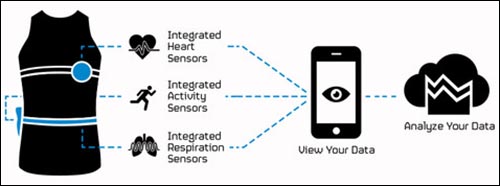Think of a full-contact version of baseball—except that everyone has a bat—and combine it with hockey and football, and you’ve got a good idea of how the Irish sport of hurling is played. The sport places enormous physical demands on elite players, and an undisclosed team in Ireland’s Gaelic Athletic Association is currently testing a sensor-equipped vest made by Canadian company Hexoskin, with sensors provided by Analog Devices, to evaluate whether the vests—in combination with data analysis provided by Microsoft—can help coaching staff to personalize training for each player, based on that individual’s performance metrics.
Microsoft is using its Azure IoT cloud-based analytics engine to collect and analyze data from the vests. This provides coaching personnel with insights into player performance, while also flagging patterns of anomalies in the data that could indicate specific players experiencing the onset of performance problems or likely to suffer injuries.
The vest contains an ECG heart-rate monitor, as well as an Analog Devices accelerometer that is used to track a player’s movements and respiration rate by tracking the number of times that his chest cavity expands and deflates per minute. Once the vest is within range, a Bluetooth radio, also integrated into the vest, transmits the data, stored in the sensors, to a paired Bluetooth-enabled smartphone, tablet or computer. The sensors can run for roughly 14 hours before needing to be recharged, which can be accomplished via a USB cable.
Hexoskin and partnering companies believe that the vest can provide a new level of visibility to professional team managers, says Jason Lynch, Analog Devices’ director of IoT strategy. Early feedback from players, he adds, indicates that the vest is more comfortable than other sensors they have worn, such as heart-rate monitors attached to a strap around the chest.
Learning as early as possible that a player is not performing at 100 percent, due either to an early-stage injury or another health-related issue, could be a boon for coaching personnel, Lynch says, because it could inform their decision-making regarding whether to pull players from training or play. This, he says, can help to reduce the chances of a significant injury.
According to Lynch, Analog Devices is already in discussions with several telecom providers about upgrading the hardware used in the Hexoskin vest to enable cellular connectivity and include a GPS chip, thereby making it possible for coaches to use the Azure platform to obtain a real-time feed of the data the sensors collect as well as their location and movements on the field. In addition, the next generation of the vest’s sensor unit would also sport a skin-impendence monitor to measure players’ hydration levels.
The companies hope to parlay this initial pilot evaluation by the Irish hurling team into partnerships with professional sports leagues elsewhere. Given the rate of injuries incurred in such American sports as football and basketball, professional teams may find the technology worth testing as well. Lynch says it’s too early to know what the Hexoskin vest would cost. Hexoskin already sells its vests to individuals, but teams buying them in bulk would likely receive a different rate. Additionally, teams would be able to purchase the vests as part of a service subscription package to cover cellular costs, as well as the Azure data-analysis delivery.
“When you’re dealing with elite athletes,” Lynch states, “they have little data to make decisions on, and typically these athletes are paid a lot, so there is a huge need for more data to make better decisions on how to keep them healthy.”
The Hexoskin vest marks a departure for Analog Devices, which generally sells its sensors in the industrial sector. But because health care is another key market the company is pursuing, partnering with Hexoskin and Microsoft makes strategic sense for Analog Devices, Lynch explains, since it allows the company to get its products into the marketplace and conduct a fair amount of research into how the sensors perform over time under real-world conditions.
“There are clinical applications that we’re interested in,” regarding tracking hydration and other heath metrics, Lynch says. The timeline for those types of products is onerous, however, due to regulatory hurdles, such as U S Food and Drug Administration (FDA) approval. “We see a lot of activity and traction in athletic wear.”
Editor’s note: An earlier version of this story said that Analog Devices manufactures the ECG heart-rate monitor in the vest. It does not. We regret the error.


